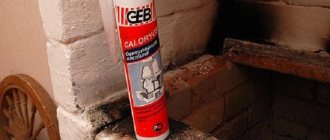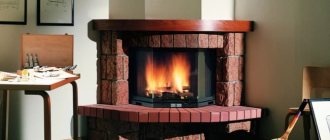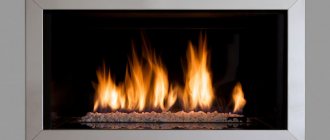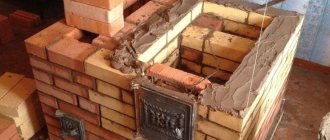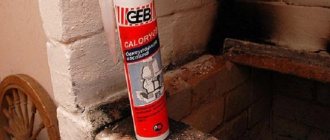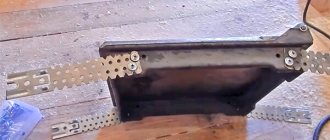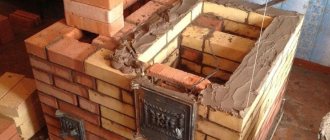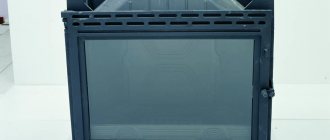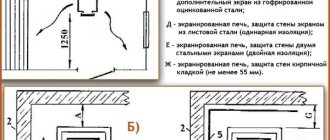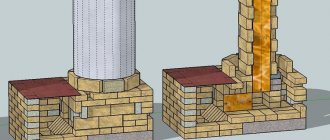Choosing clay for mortar
The mortar for laying the fireplace must be plastic and homogeneous.
The cement mixture used for stone structures cannot withstand high temperatures. For this reason, clay is used to build the frame of a fireplace or stove. The material can be purchased in stores or dug up yourself on the bank of a river or the slope of a ravine. The depth of occurrence usually does not exceed 0.5 m.
Determination of fat content
Clays are divided into normal, lean and fatty. Using a mixture based on lean rocks will result in a brittle and crumbly layer. It will not have strength and good adhesion to the surface. You can correct the situation with the help of fatty clay.
It is worth determining the fat content and calculating the amount of sand experimentally:
- Remove large fractions from 1 liter of clay and divide it into 5 parts.
- Place portions into separate containers.
- Don't add anything to the first part.
- Add sand equal to ¼ portion of clay to the second part.
- To the third part add sand to ½ portion of clay.
- Mix equal amounts of sand with the fourth.
- To the fifth mix sand 1.5 times more than the portion.
Additionally, water is added to each container. The solution is mixed to a “cool” state - homogeneous, plastic, and not sticky to your hands.
Each portion is then rolled into a ball and placed between polished bars. Press on one of them until cracks appear on the ball. A reduction in the gap between two boards by half indicates that the solution is greasy. If it was a block with portion No. 5, then the clay is oily or there is an excess of sand in it. A normal mixture will crack when the lumber is brought closer to 1/3 of the original distance.
You cannot use only oily clay - the solution may crack and shrink. You can normalize the material with sand.
Cleaning clay rock
Before preparing the solution, the clay needs to be soaked for a day.
To prepare the clay for work, it is filtered through a sieve with 3 mm cells - under a masonry joint equal to 3-5 mm. Particles with large fractions will damage the seam.
The second option for cleaning clay is alluvial. Cleaning is carried out in a long trough installed at an inclination of 7 degrees. Water is poured into the lower part of the container, and clay rock is poured into the upper part. Use a spatula or trowel to pump in liquid that will wash the clay down. At the last stage of preparation, the material is filtered.
The amount of clay and water is chosen so that they do not interact with each other.
Before preparing the solution, clean clay is soaked in a container. Pour a layer 10-20 cm thick and moisten it with water. The material reaches full impregnation and softness after 24 hours. You will need to mix it with a bayonet shovel, pour it over and leave it for another 24 hours.
Composition of the solution
It is allowed to use a mortar with a volume of 8 times less than the volume of bricks or 10-13 times less than the volume of the entire structure for laying a fireplace or stove. The indicator is calculated based on external dimensions.
To eliminate mathematical calculations, take a standard ratio of components: for 100 bricks you need approximately 25 liters of the mixture. Additional strength is achieved by adding 100-150 g of salt per 10 liters of solution. For a similar purpose, Portland cement is added in portions - 0.5-1 kg per 10 liters of solution.
The mixture with Portland cement hardens quickly, so it needs to be prepared for one-time installation.
Classification of mixtures
Purchasing ready-made mixtures for laying fireplaces saves the master from many problems. To get a solution, you just need to add a certain amount of water and thoroughly mix the dry fraction in it. Detailed preparation method and proportions are indicated in the instructions. The mixture contains all the necessary ingredients, precisely calculated in quantity.
Preparing the solution yourself will significantly save your budget, since the total cost of all materials will be lower than the price for the same amount of store-bought product. But when preparing a solution, no one guarantees complete compliance with the proportions. In addition, factory materials contain various additives that can enhance any property of the solution.
For example, to ensure that the finished solution does not contain pores with air, which will cause combustion products to penetrate the walls of the firebox, special binders are added to the masonry mixture. If you prepare the solution yourself, these problems have to be solved in a different, more complex way.
Ready-made composition from a well-known manufacturer
Each manufacturer is ready to present three main types of mixtures for various purposes. Their composition has certain differences, which affects the basic technical properties of the solution.
- Mixtures based on clay and sand are used when laying the firebox and fireplace walls. The prepared solution is suitable for laying linings and has a high degree of fire resistance.
- By adding cement to clay, you can increase its adhesion properties. The use of lime will add strength to the masonry. Clay-lime mortars are used in the construction of the upper rows of the chimney, where the effect of high temperatures is not so pronounced, but aggressive climate influences are added.
- Cement mixtures with the addition of sand have a high strength threshold. This composition is ideal for pouring the foundation, which will bear all the physical load from the structure.
Good to know: How to properly insulate a fireplace, why thermal insulation is needed
Some mixtures used for exterior finishing contain gypsum. But when choosing, everyone must rely on their own strengths in order to assess the efficiency of the work. There are substances with radically opposite properties. The plasticizers they contain do not allow the finished solution to harden quickly and allow the master to adjust the masonry over a certain period of time.
Nuances of sand selection and processing
The second component is mixed into the clay solution - fine-grained mountain sand with fractions up to 1 mm. You can distinguish it from river or sea water visually. In the first case, the grains of sand will be smooth - they are polished with water. The rock is rough, which improves the strength of the composition and the quality of adhesion to the surface.
Sand is processed by washing:
- Make a homemade sieve. 4 boards 5-10 cm wide are knocked into a square box. They stretch burlap onto the bottom, nailing it with small nails.
- The product is installed at an angle on a support.
- The sand is poured into the container in portions and watered with water from a hose.
- Dirt and dust, along with liquid, seeps through the burlap.
You can check the quality of washing by the purity of the water.
Types and properties of fireplace solutions
Mortar for the main masonry
The mortar for masonry of the stove-fireplace must ensure the strength of fastening of all structural elements. Its preparation should begin with the selection of ingredients and determination of their properties.
Main masonry
The proportion of clay and sand is 1:1, but for oily clay, use 2 parts of sand. When finished, you should get a creamy “dough”. When making a solution for the main masonry, you need to take into account several nuances:
- Introduce clean and fine sand into the composition without additional fractions - the mixture will be homogeneous, and the fireplace seam will become even and thin.
- Clay contains varying proportions of clay, sand and dust particles. You can visually identify a skinny rock with minimal stickiness by the presence of sandy elements. Normal material has a homogeneous structure, while fatty material has stickiness and viscosity.
- The brick is laid on a plastic, non-water mortar. The mixture is checked by moving the trowel. A dry one will tear, a wet one will float, a normal one will move evenly.
- Drinking quality water is allowed to settle for 24 hours before preparation.
Knead the clay dough with a drill fitted with a mixer attachment.
Foundation and outer part of the chimney
The base and outer part of the chimney are exposed to high humidity. Without knowing what mortar is used for laying fireplaces, stop at the finished product. If you understand the construction of stoves, you can make a composition based on lime or lime with cement:
- Prepare lime paste using 3 parts water and 1 part quicklime. The ingredients are mixed until the clay becomes softened.
- Prepare a working solution of 3 parts sand and 1 part dough. Cement is added to increase strength, but the proportions change. You will need 1 part cement, 8-10 parts sand and 2 parts lime paste.
- Strain the material through a sieve with 3x3 mm cells.
- Check the quality of the solution by stirring it with a wooden spatula for 3 minutes. A thin composition will not stick, a thick one will stick on in a thick layer and will be difficult to remove. Normal dough will coat the spatula with clumps or stick to a layer of 2-3 mm.
- Adjust flexibility. Lime paste is added to lean material, and sand to fatty material.
Lime building material can be stored for up to 7 days.
Plastering works
Ready-made mixture for plaster
Before decorative finishing, the fireplace is faced by applying plaster. Clay dough should be strengthened by adding various ingredients. There are several recipes.
- With lime. The proportion of components is selected based on 1 part clay, 2 parts sand, 0.1 part asbestos and 1 part lime.
- Without lime. You will need to mix 1 part clay with 1 part cement, and then add 2 parts sand and 0.1 part asbestos.
- With plaster. The solution is prepared in small quantities due to the rapid setting of the gypsum. For one serving you need 1 part sand, 1 part gypsum, 0.2 parts asbestos and 2 parts quicklime.
Regardless of the type of building material, each component is carefully measured and sifted. The components are combined dry. Water is mixed with clay until creamy and poured into the dry mass.
For tiles
Ceramic tiles are a popular finishing material for fireplaces or stoves. The use of pure clay mortar is unacceptable due to low adhesion. Cement paste is also not suitable because it cracks when exposed to temperature. For high-quality fastening of ceramic tiles, you can use the following recipe:
- 1 part cement;
- 1 part clay;
- 2 parts sand;
- water in the right quantity.
Reliability of fastening of the cladding is achieved by filling the seams so that there is a void of 5 mm on the outside. This thickness contributes to the penetration of the solution into the space and the strength of the adhesion of the masonry to the finish.
How to use ready-made mixtures
Despite the fact that the technology and procedure for using ready-made mixtures for laying stoves from purchased packaging are simplified as much as possible, you should pay attention to the mixing method. To do this, you will definitely have to use a mixer or a kind of attachment on a drill. If you try to mix it manually, you may unwittingly disrupt the technology used to prepare the solution for the fireplace.
In order to reduce the impact force, many people uncontrollably add excessive amounts of water. An error in kneading can be corrected by adding more mixture if there is any left. Evaporation of liquid already leads to disruption of technology.
The mortar for laying the fireplace needs to be prepared in portions. Start with small volumes, since initially it is impossible to determine the speed of masonry. Approximate operating time is about 60 minutes. The frozen solution cannot be re-mixed. The manufacturer indicates only approximate proportions, since a more precise amount of water depends on external conditions.
Using a mixer will simplify the work and allow you to make a uniform mixture
The most practical method is not to add the mixture to water, but to add water to the mixture powder. With this method you can control the consistency of the mixture. The study can be carried out with one movement of the trowel. To check the quality of the composition you have prepared, simply move the top layer horizontally relative to the lower layers.
- If the solution is heterogeneous and forms rips in many places, then this is a clear sign of a lack of moisture. When the groove formed by the trowel immediately floats, you will have to add dry powder.
- If the mark from the trowel remains static for a long time, then the solution for the brick fireplace is optimally prepared.
Good to know: How to install a fireplace, the subtleties of installing a fireplace system
The main advantage of ready-made mixtures is the ability to retain moisture. In the case of a homemade mortar, the bricks would have to be wetted before laying so that the air would escape from the pores. Uniform drying of the seams ensures the absence of cracks in the masonry. Professional craftsmen can perform brickwork with the smallest possible seam; aesthetically, this result is the highest degree of professionalism.
Brick laying with minimal seam
After completion of the construction of the structure, the fireplace or stove cannot be lit immediately. It will take several days for the solution to dry properly. It is possible that the final hardening of the mixture will occur while the device is running, but before cladding you need to operate the fireplace for a week.
Stages of making your own solution
To increase the strength of the mortar, Portland cement is added.
You can make a mortar for the fireplace masonry with your own hands after first selecting clay and sand. When performing work, the following technology is observed:
- Preparation of materials. The clay is soaked with water and sifted through a fine-mesh sieve. The sand is cleaned dry.
- The sand is mixed with clay and passed through a sieve again to obtain uniformity and crush possible clots.
- The mixture is checked for plasticity - it should slide smoothly from a trowel or shovel. Using this condition, a reference seam thickness of 3 to 5 mm is achieved.
- Increasing the strength of the solution. You will need to add ¾ liter of Portland cement per 1 bucket of the composition or table salt in an amount of 150-250 g. The cement is diluted with liquid to a creamy state, the salt is dissolved in water.
To lay 100 bricks flat for a fireplace with a seam of 5 mm, you will need 2 buckets of the mixture. When building a Russian stove, material consumption increases by 20%.
When laying a fireplace structure or stove yourself, it is necessary to check the quality of the mortar. The service life of the structure, protection from carbon monoxide and fire situations will depend on the ratio of the components.
Types of masonry mortars
In the process of laying stoves and fireplaces, not one, but several types of mortar are used. They differ from each other in properties and purpose:
- The mortar for constructing a stove or fireplace (main masonry) must withstand temperatures up to 1000° C.
- The solution for constructing the foundation and the outer (street) part of the chimney must maintain strength in conditions of high humidity.
- The finishing (plaster) mixture for cladding the structure requires increased strength.
- The mixture for fixing ceramic tiles must have sufficient adhesive properties.
It is necessary to consider the composition, characteristics and method of use of each type of solution in more detail.


